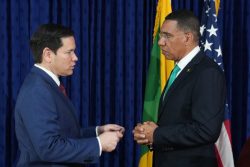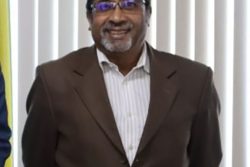Dear Editor,
During the mid to late 1950s and the eventual success of V.S. Naipaul’s House for Mr. Biswas (1961), the Trinidadian-born author was to declare that “nothing was created in the West Indies…” Of course, subsequently, Naipaul’s perspective was dramatically transformed as he was to develop an unsurpassed (to this day) engagement with the colonised and semi-colonised societies in Africa and Asia.
Naipaul’s tribute to Cheddi Jagan, it is also true, also came during his sunset phase and could be vindication of his earlier disdain for Caribbean creativity above all in the Arts. A recent letter (Stabroek News 10/9/2024) by Desmond Alli captioned “Guyanese artists continue to live in abject poverty” reflects at one level the current trolling of the notion that Guyana is destined for an autocratic state system and the inevitable deterioration of human rights. Mr. Alli, General Secretary of the Guyana United Artists (GUA) during the 1990s and even well into the Millennium, earned the reputation of a radical People’s Power, No Dictator spokesman. His pre-Colombian civilization artwork – just to mention these – provided a deeper insight into the South American visual preoccupation and was inspirational at that level.
Scanning through multiple review of the Arts Journal that consisted of a collective Arts Forum commencing during 2004, one is provided with a kaleidoscope. There is also the impression that local art culture especially that of Indo-Guyanese and those Working People’s Art Class ‘heirs’ who were victims of the ‘Destiny to Mould’ dictatorship, were availed of a new space to develop and grow. In this context a response to the specific issues the GUA founder raises would enlighten those Guyanese who otherwise could be misled or negatively influenced by Alli’s concern both legitimate and otherwise.
Peter Vieira was a recognised and talented, innovative artist of his generation. Amongst his contemporaries would have been Winston Strick, Winslow Craig and a small group of Main Street wood and leather craft producers whose items were primarily for urban tourists and souvenir collectors. Whatever tributes and rewards he would have earned were invariably the result of his creations transcending the status quo, the conceptual reaction that sustained socio-cultural alienation viz the creative impulse. Amongst these would have been relatively ‘just in time’ access to quality leather or animal hides, coupled with the intervention of often private sector sponsorship options. It is not known whether Vieira was the recipient of EU or UNESCO type of culture grants or scholarship opportunities.
However, an illustration of his applied craft could be better understood by a comparison between the public art of the Lokono Artists on the one hand and that of the Nappi-based community engaged predominantly in balata figurative artwork on the other hand. What must occupy our attention is that Vieira died under regrettable circumstances. His demise must be cause for introspection and even some questions. Was it not possible for the GUA to be more proactive, say for instance initiating an artist support – a material assed garnering for a valued figure on the local art scene? Why was the GUA not vocal on previous occasions, since let us say the 2015-2020 period, during which one assumes a number of those listed in Alli’s letter would have died?
These are important questions that should contribute to clarifications and the demystification of PPP/C impoverishment of local artists. Less we tend to forget the 2015-2020 tenure of the APNU-AFC witnessed widespread hardships amongst the working people; with the imposition of VAT, taxes on the importation of so-called non-essentials as well as budgetary cuts on allocations for productive sectors previously extended by the Ramotar administration. In other words, clear distinction must be made between the Ramotar administration’s “prosperity for all – no one will be left behind” at the first remove, and on the other, the Social Cohesion of the APNU-AFC aristocrats; the state of affairs that extended into the Covid 19 pandemic; what the late renowned activist and author Mike Davis describe as “the Virulence of Poverty…” (cf. OR Brooks, New York, London <www.orbooks.com>.
APNU-AFC’s ‘Greening of the State’ implied that essentially, there would be a return to Burnhamism. Could it be that during the tenure of the coalition a number of local artists with the exception of small ‘cluster’ of formerly Burrowes Art School grads, would have become impoverished and met their demise? 1992 October equated a national democratic awareness but did not completely eradicate PNC paramountcy. The vision that explores the range of neoliberal options is constrained by neo-conservative as well as concepts that are derivative from the persistent and on-going post Fordism of the global oligarchs. As observed by highly accredited scholarship Premdas R; Rohlehr G; Stone C; as well as our own renowned Dr. Walter Rodney, Kampta Karran and Perry Mars, the empirical utilitarian instrument of race as a polarizing device is often problematic for its practitioners to divest from one reset. The disastrous consequences of this polarisation can be witnessed in Sri Lanka, Fiji, Guyana, Jamaica, Suriname, as well as Puerto Rico.
The narrative of ethnic marginalization supposedly a trait of the PPP/C, remains as a leitmotif perhaps, to groups that are racially-based or aligned to anti-communism. This alignment often is inseparable from the pursuit of undemocratic politics. One notes the falsity in his position when it claimed that, “in the aftermath of CARIFESTA, Guyana saw for almost two decades cultural renaissance that came to an end when the PPP assumed government in 1992…” [Certainly, the ordinary man in the street who would have experienced PNC extravaganzas in the years from 1968 up until 1991/2 would conclude differently. For one core causitory…and that is the large segment of Indo-Guyanese were never part of this renaissance.]
And whilst it is true that as a concession to Miss Gandhi, Burnham personally authorised the screening of the film Gandhi, that Indian tassa drumming, kathak dancing as well as sidebars sponsored by the Indian High Commission were included as cultural agenda together with inputs from Gora Singh and Mahadai Das, the PNC dictatorship was exclusive not inclusive in terms of promotion of creative locally based Art producers. At the level of Cinema there were mediocre experiments such as “If Wishes Were Horses” and “the Berbice Revolt”. Both of which received Congress Place blessings and acclaim. These are factual as well as episodic. A reality that has been confirmed oftentimes by local as well as regional observers.
To respond to the precise issue that brands Mr. Alli’s argument. Where is the evidence for example that “the PPP is not a people centered party?” As this would relate to the welfare and material security of artists? How plausible is the claim that “lack of proper medical treatment for Peter Vieira could be attributed to the PPP government?” The real situation bereft of lies and distortions is reflected in the position of Miss Janet Jagan, who in an article drafted in 1996 has this to say: “One of the first Acts of the PPP/C government (ref. to the 1992 administration of Dr. Jagan and Samuel Hinds) was the transfer of Castellani house from a presidential residence to a home for the National Art Collection. This important Cabinet decision provides an insight to the character of the alliance government which came into office after the sterile years of PNC domination, when the arts as well as life in general suffered from the lack of vision compounded neglect.” (See Thunder, organ of the PPP; Vol. 19, No. 3, last Qt., 1996, p10)
As an avid link with the Walter Rodney principle of “People’s Power”, Alli’s pioneering artwork extolling the primacy of National Unity was installed to the northwestern section of Castellani House. And this would have had the authorization of the Castellani Board not just the Curator at the time, Elfreda Bissember. Additionally, Alli’s work (at least those he himself would have selected), were included in the catalogue initiated by UNESCO ‘of all recorded pieces of artwork in the nation’ in a computerized format (CD/mimeograph). Other artists perhaps not as experienced in terms of travel as Alli, were awarded study tours overseas including to the People’s Republic of China. The versatile and somewhat at times ‘Young Turk’ Ruel Johnson benefitted from a familarisation trip to Communist China, which during that period Alli may well regard as a Stalinist-ruled society.
The transition dating from August 2020 therefore, must be analysed in its proper context. A situation where a number of local art producers either aligned themselves with the APNU-AFC (possibly following the leader role of Dr. Rupert Roopnarine and Dr. David Hinds). Others would have maintained either an opportunistic stance re the 202 rigged elections attempt, or opted to carve a niche of their own. Mr. Desmond Alli however, may well in time have to admit his attacks directed against the Irfaan Ali government and it Arts policy is flawed. This flaw in fact results from a continuum where Burnham era Arts policy designed to entrench second class citizen status on a segment of our population and served to weaken and polarize the working people. The very social formation that will eventually consolidate democracy.
Sincerely,
Lawrence Rodney








